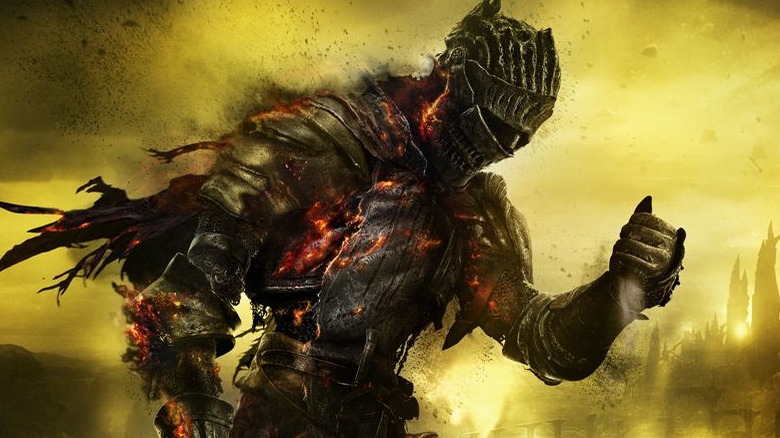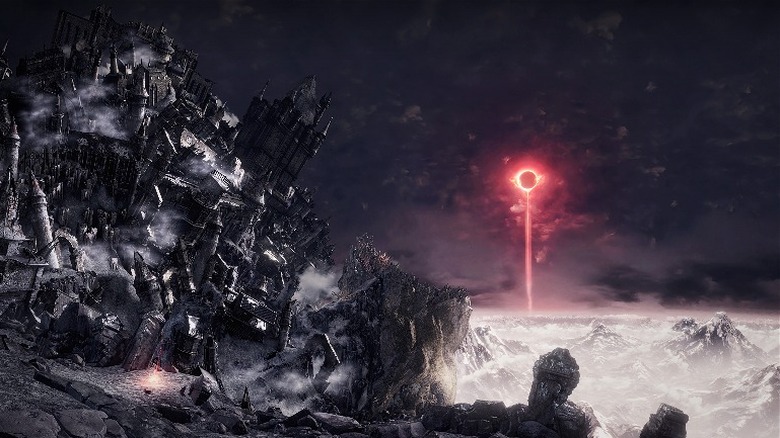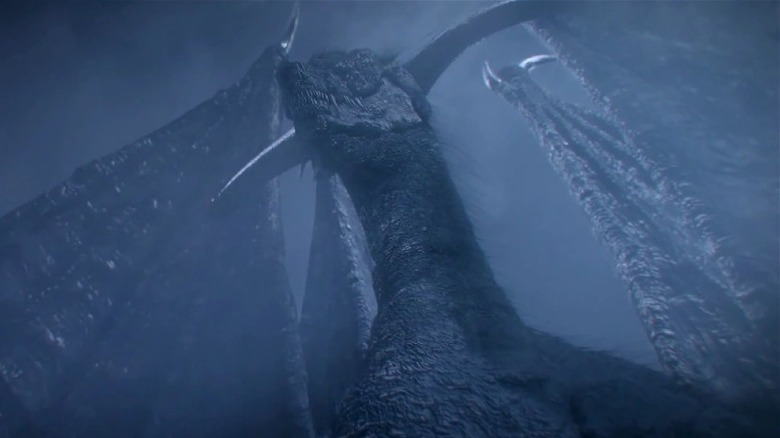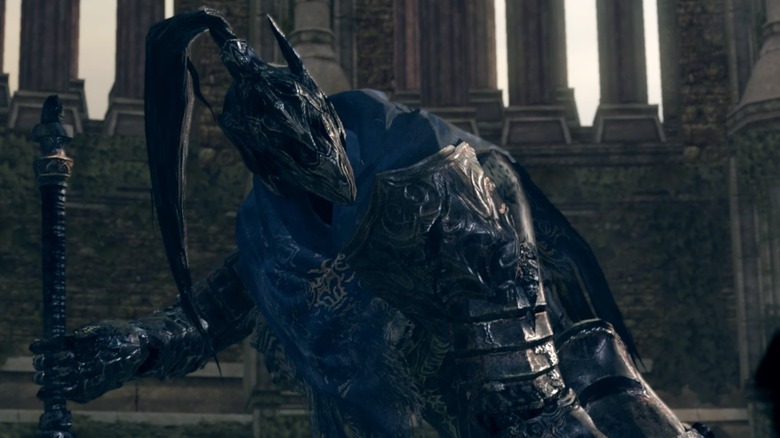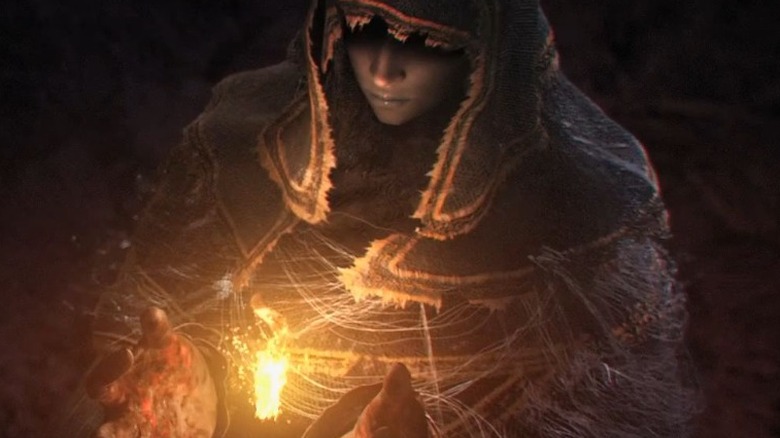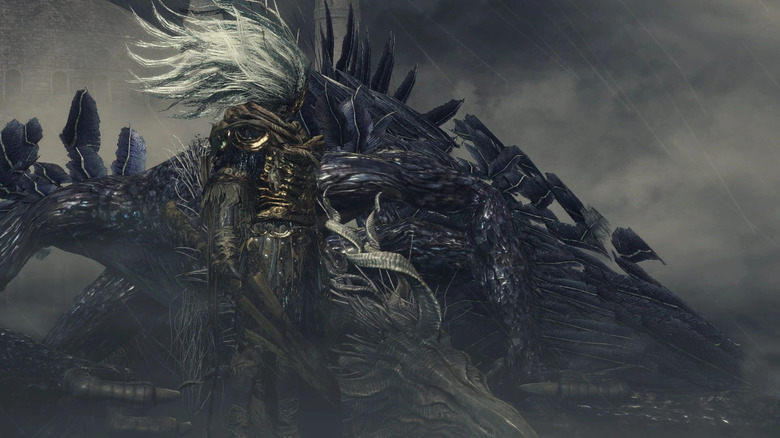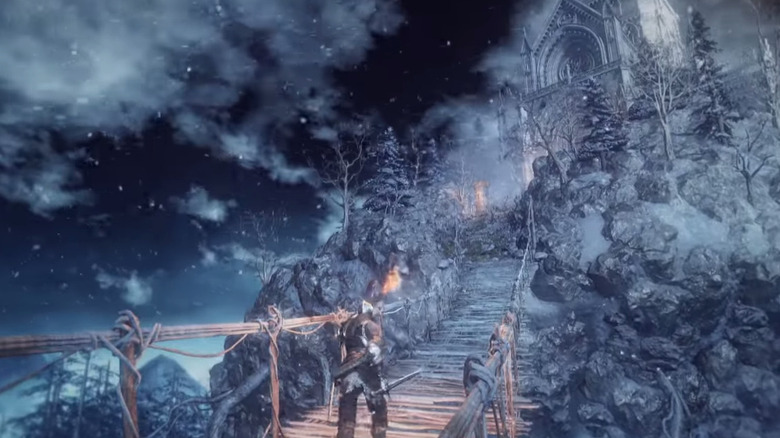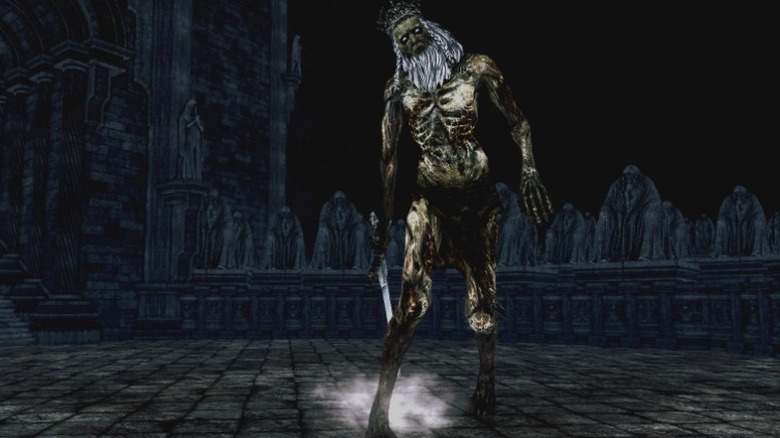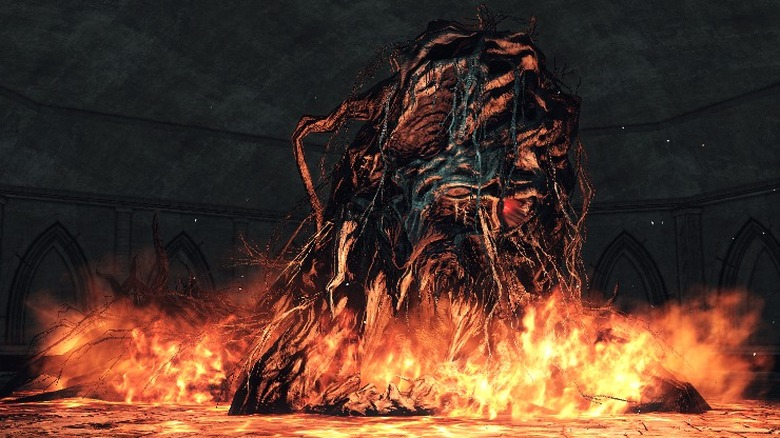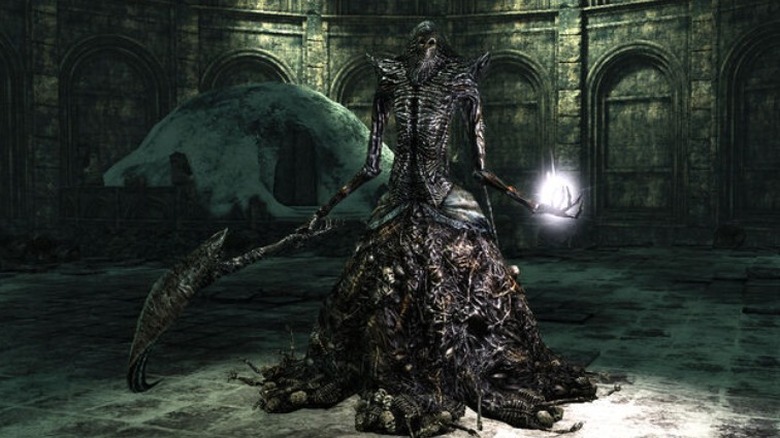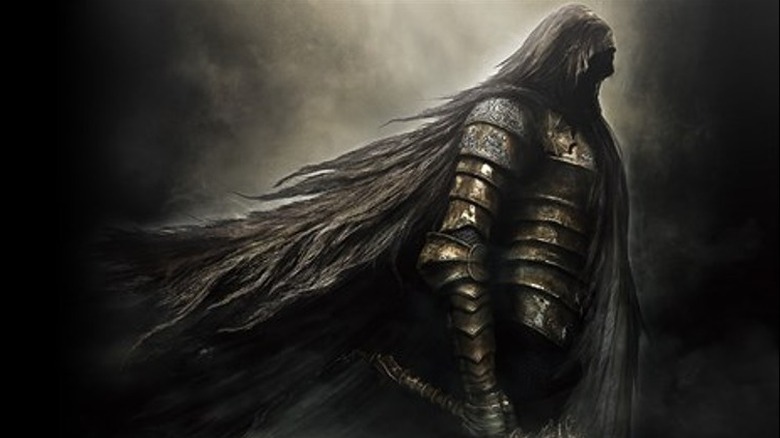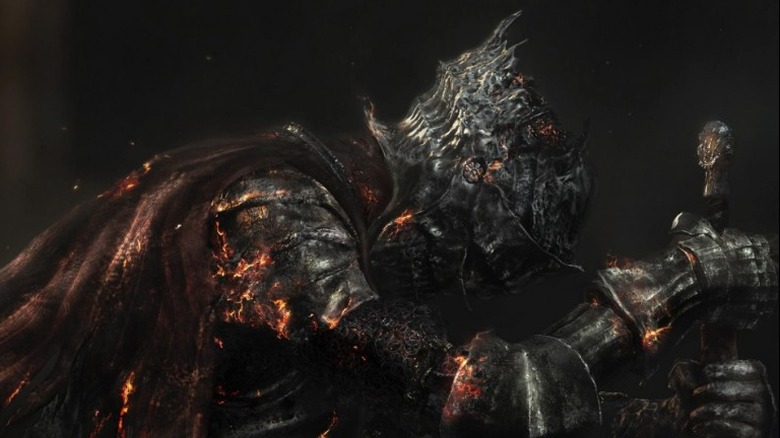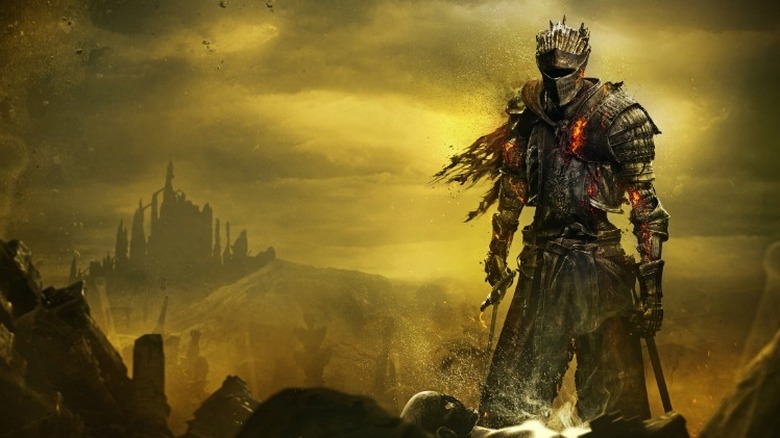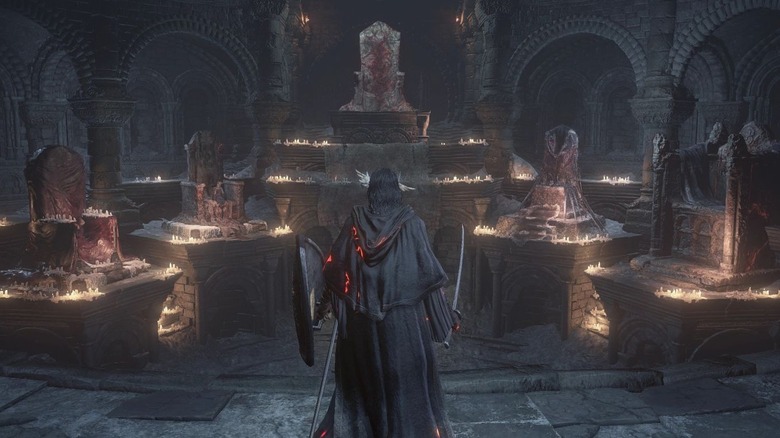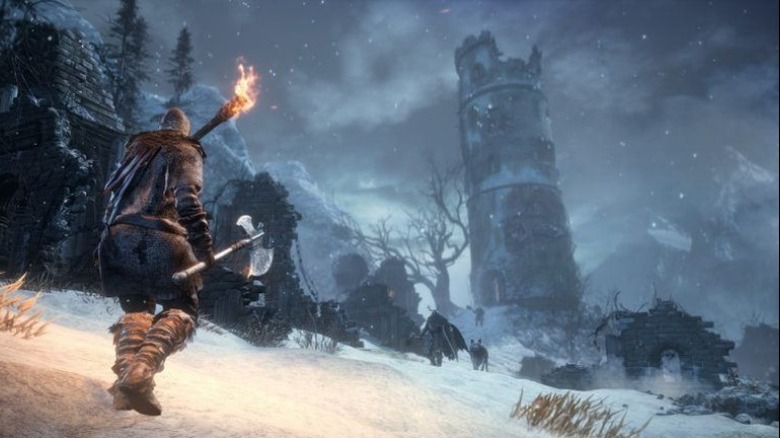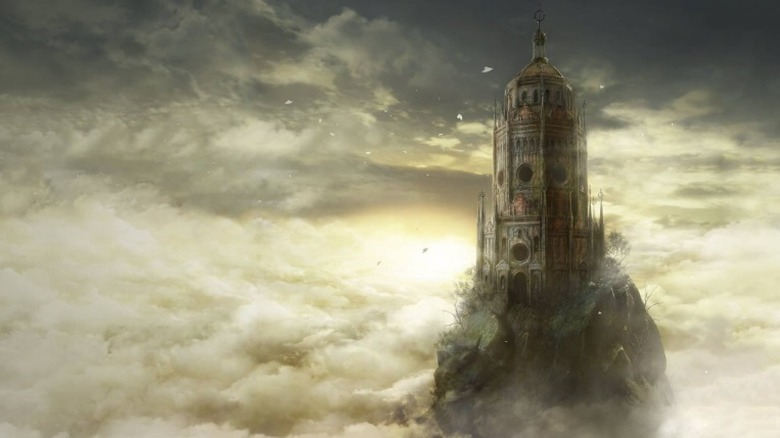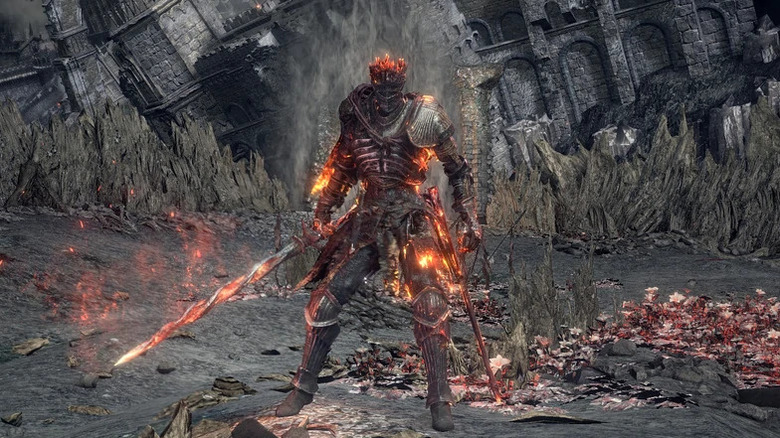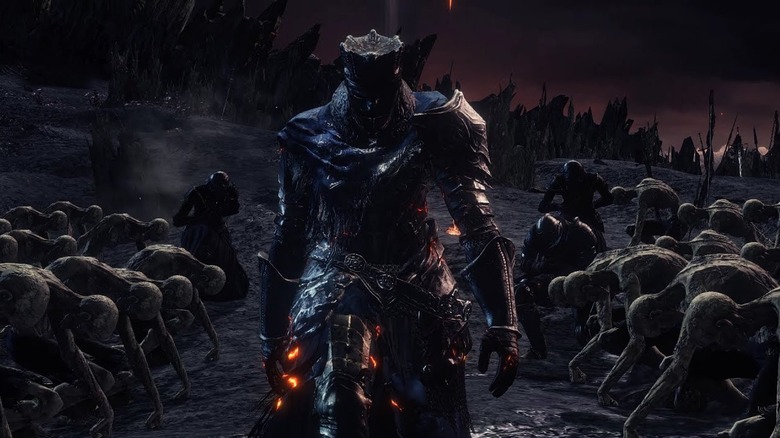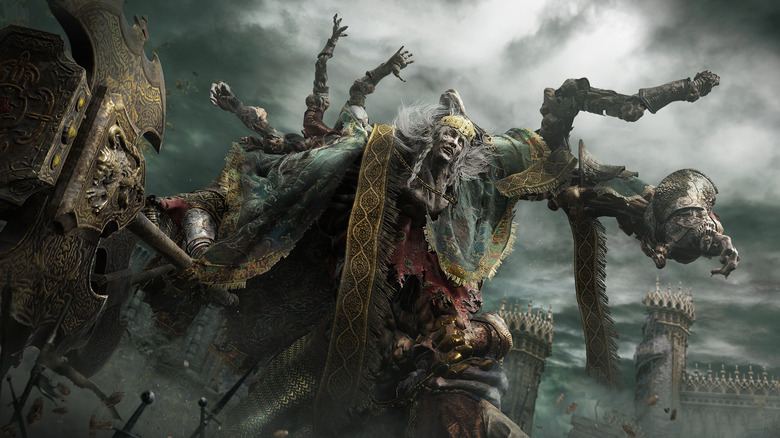The Entire Dark Souls Story Explained
There are two kinds of people in this world: those who have beaten a Dark Souls game, and those who haven't. These games by FromSoftware rank notoriously high on difficulty, often crushing players with an atmosphere as oppressive as its bosses. Yet, for every death, there's always a reason to keep trying again, no matter how futile it may seem. For whenever you want to "git gud," Hidetaka Miyazaki's games always challenge you to get back up stronger than before.
This cyclical nature of dying, resurrecting, and trying again perfectly captures the narrative of Dark Souls. Some of you may be asking, "Wait, there's a story to all this?" Yeah, there is, and it's a rich, complex one that's hidden beneath layers of subtext and literal text. So for some, beating these games is as much about narrative as it is about gameplay.
If you're interested in the deep lore of Dark Souls, we've got a quick primer to help you get started. It's worth noting that time is pretty ambiguous in this universe, especially toward the end. Nonetheless, we'll hit the major points across all three Dark Souls games.
The whole story begins with the Age of Ancients - Dark Souls
A lot of events happen before you even touch the controller in Dark Souls. Ages before you escape the Undead Asylum, there was nothing but fog. No one lived, no one died. Only dragons existed, eternally watching over everything. This era was called the Age of the Ancients.
Underground, a magical fire, called the First Flame, suddenly sparked, attracting many humanoid creatures. This legendary Flame created the dichotomies between light and dark, and life and death. Essentially, it put time in motion. Three creatures went into the Flame and claimed a Lord Soul. Gwyn took the Lord Soul of Light, while the Witch of Izalith took the Soul of Life. Nito claimed the Soul of Death. This granted them great power, turning them into living gods.
Meanwhile, the Furtive Pygmy found the Dark Soul, which provided Hollows with a precious thing called Humanity. Thus, humans were born unto this world, but their power paled in comparison to the three Lords.
Killing the dragons - Dark Souls
With this newfound power, the three Lords waged war against the dragons above ground so they could claim the surface. Unfortunately, these dragons were unable to be killed by normal means. One dragon, Seath the Scaleless, betrayed his kind because, as you'd guess from his name, he was born without scales.
He reveals to the Lords that dragons are immortal as long as they have their stone scales. However, the destructive power of lightning could strip them of their defenses. So Gwyn harnessed some lightning bolts, opening the path for the other two Lords to secure victory.
Nito released the plague of death upon the vulnerable dragons. Meanwhile, the Witch of Izalith burned their homes, so they would have nowhere to run. This series of events wiped out almost all the dragons in the world, leaving only weaker imitators, like drakes and wyverns. The only true dragon remaining was Seath. Thus, the Lords moved to the surface, claiming it for themselves.
Our story takes place in the Age of Fire - Dark Souls
With the Lords in control of the world, the the Age of Fire begins. Consider it a golden era, where everything flourished. Gwyn build Anor Londo, his capital, atop a mountain so it could be closer to the sun. Nito took over the underground catacombs, spreading the concept of death from below, while the Witch of Izalith studied fire. This led to the Pyromancy abilities we see in the Dark Souls games.
Additionally, Seath sat comfortably in this new kingdom. For his services to the Lords, Gwyn bestowed upon him the status of royalty. Seath was also provided a lab for him to conduct experiments on creatures, all in an effort to understand immortality. These often inhumane experiments angered some people in Anor Londo.
Havel the Rock, a loyal knight under Gwyn's reign, took umbrage against Seath's experiments. He started gathering a group to take Seath down, but Gwyn disapproved. The ruler eventually locked his friend away, dooming him to turn Hollow and go mad. Unfortunately, those experiments caused Seath to go crazy as well, although he eventually unlocks the secret to immortality — sort of.
Artorias and the Abyss - Dark Souls
In this universe, a little village called Oolacile sits atop the Abyss. This Abyss can be described as the darkness found within all mankind, and it could threaten to snuff out the First Flame if left unchecked. There's also Kaathe, the primordial serpent who often exhibits his desire to see the Age of Fire end. He convinces the people of Oolacile to go into the Abyss and dig up the grave of Manus, the primordial man. The creature goes wild when he's awakened, causing his Humanity to spiral out of control. This event exacerbates the growth of the Abyss.
In order to stop the Abyss, Gwyn sends his trusted knight Artorias to Oolacile. With his wolf pup Sif, Artorias confronts Manus but loses. It's at this point that Manus looks for his treasured pendant across time and space, finding it in the future. He pulls the pendant to him, along with the Chosen Undead (that's your character in Dark Souls). The Chosen Undead puts an end to Manus, saving the world from the Abyss while protecting Sif.
The first flame dwindles, setting up the beginning of the story - Dark Souls
Gwyn enjoys his prosperity for some time, but all good things must come to an end. The First Flame begins to fade. The Lords panic over this startling development, as the Flame has been the source of their power since the Age of Fire began.
The Witch of Izalith tries to recreate the Flame based on all her studies. Ultimately, she fails, and this corrupted fire consumes her soul, turning her into the Bed of Chaos. This event creates the Flame of Chaos, which spawns the multitude of demons that plague the land.
As a last-ditch effort, Gwyn sacrifices himself to the Flame, using his soul to rekindle the fire. This works, extending the life of the Flame as long as he sits within it. He becomes the first Lord of Cinder, a creature who has enough power to sacrifice itself to rekindle the Flame.
Becoming a Lord of Cinder is only a temporary solution, delaying the inevitable darkness. Additionally, by rekindling the Flame, he has cursed humanity with immortality. Undead humans always come back, but the more they die, the more they become Hollow.
Hollows and the curse of the undead - Dark Souls
The fading fire and the presence of the undead are closely linked in "Dark Souls" lore. When the gods discovered their Lord Souls, they set out to recreate the world and begin the Age of Fire. A mysterious individual known as The Furtive Pygmy, however, used its Dark Soul very differently. They split the Dark Soul apart and used its power to create humans. The gods had little regard for humanity until Gwyn's flame began to fade. Desperately searching for a way to keep the flame alive, the gods discovered that humanity could be used as kindling for the fire. Unfortunately for the gods, humans had very little motivation to burn a piece of themselves away.
That is, until the curse of the undead crept over the land. Over time the undead begin to lose their sanity and turn Hollow. The only way to keep themselves from becoming Hollow is to gather humanity and offer it to bonfires throughout the land. Burning humanity reverses Hollowing and sustains the Age of Fire – though the sustenance of burning humanity isn't as strong as a Lord offering themselves up to fully rekindle the First Flame. No one knows for certain where the curse of the undead originated, but it is suspiciously convenient for Gwyn and the other gods who want the Age of Fire to go on endlessly.
The Chosen Undead is our gateway into the story - Dark Souls
Believe it or not, we've finally reached the events that you actually play through in Dark Souls (aside from that little detour with Manus). The Chosen Undead awakens, and they're meant to fulfill the prophecy of rekindling the Flame. They strive to gather enough power to sacrifice themselves and become a Lord of Cinder, at least according to prophecy.
To do so, they have to reach the Kiln of the First Flame. To open that pathway, the Chosen Undead needs to collect the Lordvessel and the fragments of Gwyn's soul (in other words, specific bosses). They sacrifice these fragments to the Lordvessel, which provides access to the Kiln.
Within this Kiln, they find the cindered husk of Gwyn. It attacks, acting as the final boss in Dark Souls. After defeating it, you're given a choice. You can rekindle the Flame, as the prophecy intended, or you can let it die. If you choose the latter, the Chosen Undead become a Dark Lord, and a whole host of primordial serpents — including Kaathe — worship them for ushering in the Age of Dark.
Gwyn's children and the Nameless King - Dark Souls/Dark Souls 3
Gwyn, the First Lord of Cinder had four children, two of which players can see in "Dark Souls." The Chosen Undead encounters Gwyn's first daughter Gwynevere while exploring Anor Londo. She urges the Chosen Undead to overthrow Gwyn and rekindle the flame to continue the Age of Fire. If the Chosen Undead attacks Gwynevere at any point, she fades away, revealing that her presence was actually an illusion created by Gwyn's second born son, the Dark Sun Gwyndolin, who wants to find a worthy undead to rekindle the flame.
Players see Gwyn's second daughter, Filianore, in the "Dark Souls 3" Ringed City DLC. After the war with the dragons, Gwyn separated the Pygmies from the rest of the world by putting them in the Ringed City, and he sent Filianore to live with them for reasons that aren't entirely clear. She holds a cracked egg that crumbles when touched and transports players to the game's final boss battle.
The most mysterious of Gwyn's children is his firstborn son. Players learn in "Dark Souls" that Gwyn's firstborn was a celebrated God of War who suffered a humiliating loss. The firstborn's mistake forced him out of Anor Londo and ensured that his name was lost to history. The identity and fate of Gwyn's firstborn was the subject of fan speculation for years, but many believe that he is in fact the Nameless King, an optional boss in a hidden location in "Dark Souls 3." If that's true, then after being separated from his family, Gwyn's firstborn took up with the very dragons he had once warred against.
Secrets of the Painted World - Dark Souls/Dark Souls 3
One of the most unique locations in "Dark Souls" is the Painted World of Ariamis. Hidden inside a painting hanging on a wall in Anor Londo, this world is protected by heavily-armed guardians and is the home of Priscilla, a dragon hybrid with incredible power who initially asks the protagonist to calmly leave before attacking.
The reason behind the Painted World's existence is one of the enduring mysteries of "Dark Souls," but fans have done their best to uncover the secret. One popular theory is that the Painted World was built as a prison for beings that the various Lords viewed as threats to their power. The first DLC for "Dark Souls 3," on the other hand, brought players to the Painted World of Ariandel. The game doesn't openly spell out the connection between this Painted World and the one encountered in "Dark Souls," but fans have used their sleuthing abilities to put the pieces together.
Ariandel is known as the "restorer of the Painted World," which implies that Ariandel's Painted World and Ariamis' Painted World are one and the same. No one knows how much time has passed between the events of "Dark Souls" and "Dark Souls 3," but it's clear that the Painted World has gone from being a prison to being a home for people, like Slave Knight Gael, who want to escape the real world's woes (more on him in a bit). Notably the Painted World exists in a cycle similar to the Age of Fire. As the painting ages, it must be burned away, and its residents must create a new painting where they can escape, continuing the cycle of life and decay. Even the alternate dimensions in "Dark Souls" have a long story of their own.
Vendrick and Drangleic rekindle the story some time later - Dark Souls 2
Whatever ending you choose in Dark Souls doesn't matter in the grand scheme of things. The franchise is all about cycles, after all. Ultimately, someone else always comes in to rekindle the Flame.
An undisclosed amount of time has passed since the Chosen Undead's time. Many kingdoms have risen and fallen, and the Flame has been rekindled an unknown number of times. Dark Souls 2 puts its focus on the kingdom of Drangleic. King Vendrick founds Drangleic after overthrowing the previous kingdom that stood in its place.
From across the sea, a traveler named Nashandra joins Drangleic, warning Vendrick of an incoming invasion. She claimed the giants were coming to attack their kingdom. Hoping to gain the upper hand, Vendrick leads his army to the giants first, attacking them and stealing a powerful artifact from them. This artifact helps him build magical golems, which in turn contributed to the construction of Drangleic.
The undead curse - Dark Souls 2
Drangleic prospers for some time under Vendrick's rule. He marries Nashandra, who becomes the queen of the realm. Unfortunately, the curse of the undead has returned to the world. Many people have become afflicted with this curse, which eventually leads to them becoming Hollow. At first, he quarantines these people, treating them as nothing more than an infection.
But after some time passes, the king realizes that there's more to it than that. Vendrick and his brother Aldia deduce that this undead curse historically appeared when the Flame was rekindled. They suspect that somehow, the two are related.
Aldia, who studied life and death itself, tried to find a way to live outside the cycle. He resorted to recreating dragons, the ancient creatures unaffected by time before the Age of Fire. He goes as far as to create a hybrid being, but nonetheless, Aldia finds no surefire way of escaping fate. No matter how hard he tries to stop the undead curse, he fails, ultimately turning into a horrifying monster.
Nashandra's ulterior motive - Dark Souls 2
While Vendrick was trying to provide for his kingdom, he had no idea of the sinister plot his wife was hatching. Nashandra was born from a shard of Manus, the primordial man who embodied the Abyss. She represents everything dark about humanity, and the only thing she wants is to usher in an Age of Dark. She believed that by siding with Vendrick, he would lead her to the Throne of Want, which represented the First Flame.
We learn that the giants were never planning to attack Drangleic. Instead, it was Nashandra who manipulated Vendrick into fighting them. She knew they had the golem-building artifact which would help Dranglaic prosper. The giants came back with a vengeance, decimating the kingdom.
Vendrick learns of his wife's betrayal, but by the time he realizes, it's too late. He seals himself away so he can't be used by Nashandra to reach the Throne of Want. However, that doesn't matter to her. She's found a new entity that can open the way to the throne: your Dark Souls 2 character.
The Bearer of the Curse concludes a new story cycle - Dark Souls 2
Your character in Dark Souls 2 is another Undead, but this time, they're closer to becoming Hollow. Everyone, including your character, flocks to Drangleic in search of a cure. Instead of finding it, though, the Bearer of the Curse finds themselves drowned in this political power struggle for the First Flame.
Nashandra tells the character sweet little lies, nudging them toward opening the Throne of Want. She herself can't do it because of the barriers Vendrick set up. After the path opens, Nashandra, in a surprising twist that no one could see coming, betrays the Bearer of the Curse. They fight before the throne, but your character ends up victorious.
Originally, Dark Souls 2 funneled players into one ending, which made the protagonist sit on the Throne of Want. The meaning was left ambiguous, but many assumed this meant rekindling the Flame. When the game got the Scholars of the First Sin update, an ending was added that let players walk away from the throne instead.
Scholar of the First Sin - Dark Souls 2
After defeating Nashandra and Aldia, players have a choice eerily reminiscent of the one made at the end of "Dark Souls." The Bearer of the Curse can choose to sit on the Throne of Want, or to walk away from the Throne forever. Essentially, the Bearer can choose to once again continue the Age of Fire or let the flame fade away.
Having to make this decision once again seemingly undercuts whatever decision players made at the end of "Dark Souls," but that's exactly the point. Aldia's dialogue finally reveals that Lord Gwyn committed the "First Sin" by starting the Age of Fire. This is how the protagonist learns that Gwyn's Linking of the First Flame began the cycle of light and dark and inadvertently created the undead curse. Now the cycle continues forever — no matter what happens. If a powerful undead rekindles the fire, it will inevitably fade. If that undead chooses instead to walk away, someone else will come to take their place. There is no cure for the undead curse, and even when an in-game crown offers respite from Hollowing, it only masks the symptoms; it doesn't eliminate the curse entirely.
Some believe that Aldia tried to break this cycle by usurping the First Flame. Though he was unsuccessful, his work and research had lasting effects on the world. The cycle would continue past Aldia, but on the horizon, an Unkindled was coming who could truly bring an end to the First Sin.
The Lords of Cinder brings the story to its end - Dark Souls 3
Here we are, at the end of the world. We travel forward in time, at another cycle of rekindling, possibly one of the last. The First Flame is dying once again, and the Lord of Cinder who would have rekindled it, Lothric, refused to do so. Thus, previous Lords were brought back to life so their power could be used to rekindle the Flame.
Ludleth, one of the Lords, sits on his throne at the Firelink Shrine, accepting his fate as nothing more than a sacrifice. Lothric remains past the Grand Archives with his brother, Lorian. The other three Lords — Yhorm the Giant, the Abyss Watchers, and Aldrich, Devourer of Gods — continue to wander the world, carrying their Lord Souls with them.
All five of these Lords come from different places in the Dark Souls timeline. We never saw these characters in the height of their power, but based on their relationships with other bosses, we know they held power in this world before they gave their bodies to the Flame.
The Ashen One - Dark Souls 3
With the Flame fading, bells ring out, awakening the Unkindled. These creatures differ from the Undead, who generally seek humanity and darkness. Instead, the Unkindled seek the Flame itself, gathering little Embers as they can. There's a possibility your character used to be an Undead who couldn't handle the Flame, which at least explains why the Humanity item was replaced with Ember in Dark Souls 3.
The Ashen One rises as yet another prophecy-fulfilling creature that stands above the rest. It's up to them to harvest enough souls to become powerful enough to gather all five Lords of Cinder and bring them to the Firelink Shrine. Ludleth is already there, meaning you have at least four boss fights to look forward to (one of which is surprisingly easy).
Each Lord has a deep background story that provides more insight into the history of Lothric. While we won't go into detail on each of them, you should know that they again speak to the cycles of rising and falling empires that Dark Souls has become known for.
The endlessly repeating cycle - Dark Souls 3
"Dark Souls 3" hammers home the idea of a world trapped in an endless cycle that was first introduced in "Dark Souls 2." Once again players are exploring a world plagued by a fading flame. The game's main bosses are all Lords who have previously linked to the flame, showing that rekindling isn't really the solution to the problem of fire's fading.
Tis inescapable cycle is so important to the story of "Dark Souls 3" that FromSoftware decided to bring back specific characters and locations from previous entries to show that little has changed, despite the countless years that have passed between the games' events.
Some have taken issue with the amount of "Dark Souls" references in "Dark Souls 3," but these references serve as a powerful reminder that rekindling the flame doesn't alleviate the curse of the undead. Even though the world undergoes dramatic changes with each rekindling, poor characters like Siegward of Catarina are forced to go on living until they become Hollow. At the end of the game, players are once again asked to rekindle the flame or walk away and plunge the world into darkness. Anyone picking up on the hints left by FromSoftware probably longs for another possibility, and the ending of "Dark Souls 3" finally allows for that option.
The Painted World of Ariandel - Dark Souls 3
Along their journey, the Ashen One meets Slave Knight Gael. He's an exhausted man who has lived since Gwyn's time, and he carries a sliver of a magic painting. When touched, this painting brings our hero to the world of Ariandel. Gael pleads that the Ashen One bring fire to this world, because as it is now, it's rotting.
Many forlorn creatures call Ariandel home, making it a sad final destination for those with nothing else to live for. This world, much like the outside world of Dark Souls, falls victim to cycles. These painted lands eventually succumb to rot, which can only be cleansed by fire. By that point, the designated painter will have painted a new world for these inhabitants to jump to. In this cycle, a young, nameless girl is the painter.
Within Ariandel, our hero meets Friede, another Unkindled who now calls this place home. Despite her inherent drive to find the Flame, she and her father refuse to bring fire to this world. This sparks a clash with the Ashen One, who fights her to the death. Their altercation sparks a flame, which starts to burn Ariandel.
The Ringed City and the end of time - Dark Souls 3
While the Ashen One sets Ariandel ablaze, Gael roams the outside world, gathering as much of the Dark Soul as he can. He ingests bits and pieces of it, incorporating it into his blood. He harvests the Dark Soul by killing Pygmies, descendants of the original Furtive Pygmy who found the Dark Soul.
His goal is to turn the Dark Soul into a pigment, which the painter can use to paint a new world as Ariandel burns to nothingness. Theoretically, this new world would never die because of the enduring properties of the Dark Soul. This noble quest brings Gael to the end of the world and time itself, and his changing blood drives him mad. Now, he only wants blood and the Dark Soul, forgetting his initial reasoning.
The Ashen One travels to the Ringed City, the last city of humanity. While there, they magically travel to the end of time, where they find Gael. The slave knight attacks them, hungry for blood, but they strike him down, obtaining the Blood of the Dark Soul. The Ashen One gives this to the painter, who then paints a new, eternal world called Ash.
The meaningless finale - Dark Souls 3
There are four possible endings to "Dark Souls 3." The most straightforward ending sees the Ashen One defeating the Soul of Cinder before rekindling the First Flame. This ending perpetuates the Age of Fire, with the Ashen One becoming yet another Lord who must sacrifice themselves to the flame. With the help of the Firekeeper, it's also possible to let the First Flame fade entirely, ushering in a temporary Age of Darkness before a new flame appears. Players are also free to kill the Firekeeper and literally take the ending of the flame into their own hands. That third option, however, is effectively the same as the second one, though it's a bit morally questionable.
All three of these endings are nearly identical to the endings of "Dark Souls" and "Dark Souls 2." Whether or not the flame is rekindled, the cycle of light and dark will continue on undisturbed. Essentially, the Age of Fire is perpetuated, and the world is left with only surface-level changes after the Ashen One's journey. The Painted World of Ariandel still exists separately from the real world, but anyone who hasn't escaped into the painting will still experience the undead curse. If the Ashen One wants to break the cycle, they will need to do what Aldia, Scholar of the First Sin failed to do: Usurp the flame.
Usurping the flame - Dark Souls 3
The only way to break the Age of Fire's endless cycle is to unlock the most complicated "Dark Souls 3" ending. First, the Ashen One must become a Hollow themselves. Once Hollow, they must perform a wedding ceremony with the body of Anri as preparation for becoming the Lord of Hollows. Then, after defeating the Soul of Cinder, the Ashen One can put an end to the First Flame while also claiming its power. The usurpation of fire ending puts an end to Gwyn's Age of Fire and begins the Age of Hollows.
It's easy to view the usurpation of fire as the best possible ending for "Dark Souls 3." After all, Gwyn's prolonged Age of Fire has caused suffering for just about every living creature in the world. However, some fans have their doubts about how much good a new Age of Hollows could actually do for the world. An Age of Hollows might free humanity from its enslavement to fire, but it won't necessarily let them be free to live and die as they choose. There's also no guarantee that usurping the fire will put an end to the undead curse. Perhaps, like the Painted World, the Age of Hollows will simply offer humanity the chance to exist in a new kind of cycle.
An entire FromSoftware universe?
"Dark Souls" pushed FromSoftware into the mainstream, but the company's other games — including "King's Field," "Demon's Souls," "Bloodborne," "Sekiro: Shadows Die Twice," and "Elden Ring" — are just as beloved (if not more so) than its flagship franchise. There are often thematic overlaps frequently tied to game mechanics, like the need to have players retry stages to figure out proper strategies and the presence of the undead in most of the games. Certain weapons like the Moonlight Greatsword and Storm Ruler have also appeared across FromSoftware's different titles (as noted by Game Informer). Not only that, but one character connects every "Souls" game: the fan-favorite Patches, who seems to be stuck in his own cycle of death and rebirth.
These subtle connections are likely just FromSoftware paying homage to some of its favorite early ideas, but that hasn't stopped fans from speculating about a narrative connection between the various games.
One popular theory is that the Painted World created with the Dark Soul in "The Painted World of Ariamis" and "The Ringed City" DLCs is actually the city of Yharnam of "Bloodborne." Unfortunately, that theory doesn't account for the presence of the godlike Great Ones in Yharnam. Another idea links FromSoftware's first three "Souls" titles with "Elden Ring," positing that the Lands Between existed long before the other worlds, and that each of the various "Elden Ring" endings gave rise to a different FromSoftware world. The company hasn't confirmed any links between its games, and it likely never will, but that only makes theorizing about an interconnected mythology more enticing.

